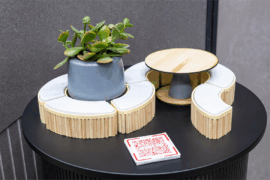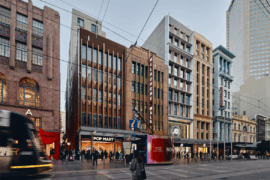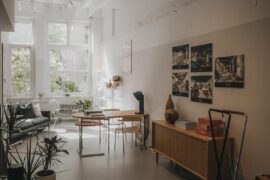Make Architects has completed work on an iconic sandstone building in Sydney’s CBD. With light heritage touches and an emphasis on public connection, Capella Sydney is a new hotel filled with architectural grace.

The main entrance from Farrer Place, all existing facades have been retained and restored.
May 8th, 2023
Working on heritage buildings is painstaking at the best of times. When an institutional piece of Sydney sandstone architecture comes up for renewal, the gravity of the task is even more intense. Having begun work on the project back in 2015 – it involved mapping every last part of the building – Make has recently completed the reincarnation of what was previously the NSW Department of Education as Capella Sydney.
“We knew there was so much of this building that should be retained and that’s why we made sure we knew every single bit of it,” says project lead Michelle Evans. “We were able to preserve it and, while these sandstone buildings have lots of connotations, we wanted people to come in and feel welcome in the space. The whole idea is that we’re giving it a new lease of life.”

The experience of this building starts well before one enters. At Farrer Place, one of those delightful pockets of small open space that can be found around the northern end of Sydney’s CBD, the heritage facade has room to breathe. The grandeur of the building can be appreciated and the main entrance is particularly striking.
The entrance points are especially notable from a heritage perspective, adding character and even a sense of majesty. Make, however, has been at pains not only to honour the building’s grand thresholds but also to create a welcoming gesture by blending with the life of the surrounding city: “We always wanted to connect the public to the inside of the building,” says Evans.

“We’re trying to bring people in. The whole ground level is public and it centres on the courtyard – anyone can come in here – that civic nature was a key design move for us,” she adds. “The brief was always about opening up the building to the public.”
The general atmosphere of openness is achieved through sightlines and a mixed use focus. The site’s uneven ground creates opportunities for variation in terms of visual connections between inside and outside, while the atrium acts as a light-filled anchor tying vertical and horizontal spaces together.
Related: 80 Charlotte Street, London by Make

“We wanted to give that sense of volume with the atrium. What’s really lovely is that when you’re in the corridors looking down, you can see down into that space,” says Evans. The atrium acts as a courtyard and, with its height and light, is reminiscent of a North African riad. This is where the life of the hotel coheres, with mixed use spaces such as the bar, restaurant and guest lounge connecting off to the sides with beautiful interiors by BAR Studio.
Moving up through the building, the majority of hotel rooms sit within the heritage envelope of the building while maintaining visual connections with the surrounding city as well as the interior courtyard and circulation spaces. “At roof level we have added four new levels also housing guest rooms. These have the same design language as the heritage but with different proportions and floor to ceiling windows. We have set back the new facade from the heritage because the idea has always been about celebrating sandstone. Whatever we put on was always to be a lighter, finer touch, and sightlines were really important,” explains Evans.

Another key move has been to place a swimming pool up on level 6, on the northern side: “There was a planning restriction that required this space to remain whole and it couldn’t be subdivided. Rather than double up on events space, we had the idea of putting the pool up here – and I’m so pleased with the outcome. Essentially, we kept all of the existing structure and just built in a new independent pool structure that sits on top. It was considerably complex, but worth it,” says Evans.
The architects also speak of the need to design this project with a fifth facade very much in mind. Given the surrounding high-rise city buildings, as well as guest room views from within, the visibility of the roof and its heritage fabric formed important considerations. It’s a project that has handled architectural heritage respectfully while opening up the building for a new lease of life.
Make Architects
makearchitects.com
Photography
Tim Kaye










We think you might also like this story on Make Architects‘ 14 storey residential tower in Chatswood.
INDESIGN is on instagram
Follow @indesignlive
A searchable and comprehensive guide for specifying leading products and their suppliers
Keep up to date with the latest and greatest from our industry BFF's!

From the spark of an idea on the page to the launch of new pieces in a showroom is a journey every aspiring industrial and furnishing designer imagines making.

Merging two hotel identities in one landmark development, Hotel Indigo and Holiday Inn Little Collins capture the spirit of Melbourne through Buchan’s narrative-driven design – elevated by GROHE’s signature craftsmanship.

Sydney’s newest design concept store, HOW WE LIVE, explores the overlap between home and workplace – with a Surry Hills pop-up from Friday 28th November.

In an industry where design intent is often diluted by value management and procurement pressures, Klaro Industrial Design positions manufacturing as a creative ally – allowing commercial interior designers to deliver unique pieces aligned to the project’s original vision.

From radical material reuse to office-to-school transformations, these five projects show how circular thinking is reshaping architecture, interiors and community spaces.

Designed by Woods Bagot, the new fit-out of a major resources company transforms 40,000-square-metres across 19 levels into interconnected villages that celebrate Western Australia’s diverse terrain.

In an industry where design intent is often diluted by value management and procurement pressures, Klaro Industrial Design positions manufacturing as a creative ally – allowing commercial interior designers to deliver unique pieces aligned to the project’s original vision.
The internet never sleeps! Here's the stuff you might have missed

From radical material reuse to office-to-school transformations, these five projects show how circular thinking is reshaping architecture, interiors and community spaces.

With the opening of the 2026 INDE.Awards program, now is the time to assess your projects, ensure photography is at hand and begin your submissions.

At the Munarra Centre for Regional Excellence on Yorta Yorta Country in Victoria, ARM Architecture and Milliken use PrintWorks™ technology to translate First Nations narratives into a layered, community-led floorscape.